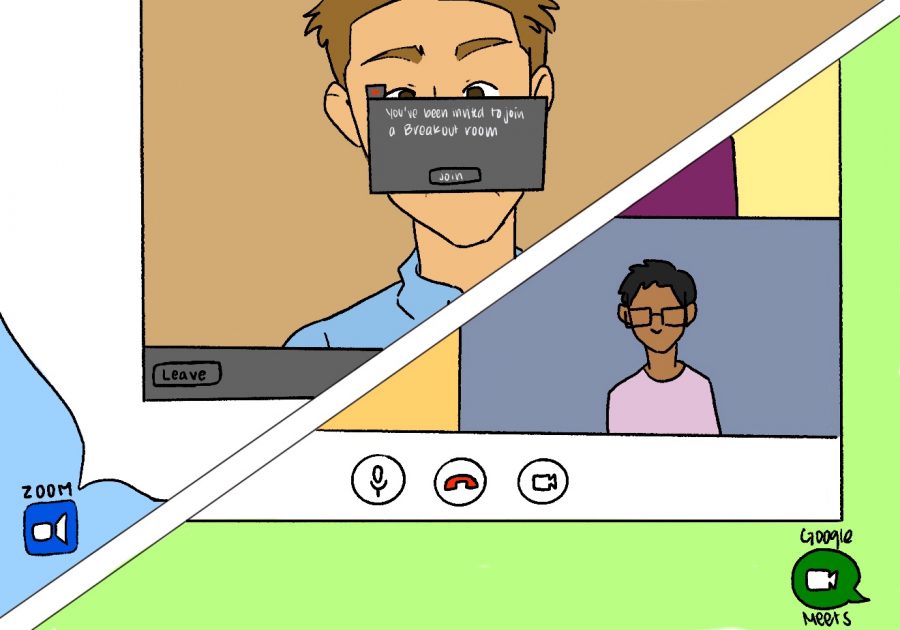Nine-year-old video conferencing platform Zoom (left) provides advanced options like breakout rooms; for others, 3-year-old competitor Google Meet offers a minimalist, easy-to-understand format without the experience of advanced features.
BATTLE OF THE VIRTUAL PLATFORMS
September 5, 2020
In response to the Fullerton Joint Union High School District’s decision to enter full distance learning for the beginning of the 2020-2021 school year, two Accolade reporters debate the merits of the main platforms for at-home learning: Google Meet and Zoom.
Zoom’s ranked No. 1 among certain users for a reason
Ranked No. 1 in the business category and 4.5 out of five stars from over a million ratings in the App Store, Zoom is the newest, tech-savviest educational platform for our stay-at-home, COVID-19 times.
In response to the global pandemic that caused the closure of all Fullerton Joint Union High School District [FJUHSD] schools in March for the 2019-20 school year, FJUHSD opted for distance learning using one of two platforms: Zoom and Google Meet.
However, the district chose Zoom as the official platform for this school year since some of Google’s features for its video calls will no longer be free after September, according to support.google.com.
Consequently, the FJUHSD definitely made the right decision in choosing Zoom because it offers education-oriented features that Google Meet lacks and provides better security measures to make sure teachers can keep their meetings to strictly their own students.
For example, Zoom allows teachers — or whoever creates the meeting — to enable a waiting room where all participants will enter before the host manually accepts each student into the meeting. As a result, this feature prevents the several “Zoom-bombings” that occurred last year where unauthorized students joined meetings and harassed teachers with obscene words.
Although Google Meet includes a similar feature that allows the host to deny entrance to accounts outside of the organization — FJUHSD in this case — Zoom enables hosts to check everyone who requests to join the meeting regardless of whether they are in the organization or not.
Personally, I’d hear of these ‘Zoom-bombings’ last school year from friends, but so far, I have not experienced or heard about any of these incidences because Zoom will block any participants who are not logged in with an fjuhsd.org account and any other participant whose name is not on the class roster.
In addition, Zoom breakout rooms give teachers the ability to separate students into smaller work groups during the meeting, optimal for when assigning group projects or smaller discussions. Hosts can create breakout rooms depending on different topics or categories and individually place students into different groups.
Some students may feel like they cannot connect with the students they are in the breakout room with, but this feature almost exactly replicates the experience of having to work with assigned groups. Group work is a crucial aspect of classroom learning, and the ability to continue with it through distance learning outweighs the “awkwardness” students may feel in a breakout room.
Furthermore, Zoom offers a poll feature that Google Meet does not offer.
For example, my Korean IBHL 2 instructor, Joe Ok, kept me and my peers engaged on the first day of school with a Zoom poll that popped up on our screen asking if we were happy with a yes or no option for us to vote on. After we all submitted our vote, he shared the results with the class and even asked the students who answered “no” to elaborate why and tried to talk it out with them.
Already from the first day of school, I felt that this new semester of Zooming would be different than last semester.
Lastly, Zoom contains a recording feature during its meetings in which the host can choose to record the meeting from a point they choose. As a result, teachers can video record their lectures of instructions and post it onto their Google Classrooms for students who missed the class or just for those who wish to review the lecture for extra help.
Unlike Zoom, Google Meet’s special features such as recording and holding more participants (up to 250) will only be free until Sept. 30, according to support.google.com.
If Zoom is the patriarch of the video-conferencing industry, Google Meet is in comparison merely a child in the development stages — immature and inexperienced.
Therefore, Zoom truly has proven its effectiveness for our school district’s distance learning format. By equipping several optimal features for various aspects of the classroom setting, it provides defense mechanisms against potential disruptions to the class.
According to the official Zoom website, Zoom is ranked No. 1 in customer reviews, and it seems to have proven just that.

Meeting out the differences: Google’s much simplified features top Zoom
Last semester, as our school suddenly transitioned into online learning in mid-March, only two of my seven teachers frequently used Zoom as their main form of video meetings with students. Of the others, three of them recorded their lessons and two utilized Google Meet to teach.
This surprised me because I originally thought Zoom was the preferred platform with its No.1 ranking in customer reviews. However, I found that some of Zoom’s features are not as favorable as what Google Meet has to offer.
The most notable drawback was the “Zoom bombing” that happened frequently last year. Some of our instructors were victims of these rude visitors, and a few of my teachers admitted that they avoided the virtual meeting platform for that reason.
Instead, they recorded their lessons ahead of time and posted them on Google Classroom or utilized Google Meet, which didn’t have a reputation of frequent unwanted visitors joining the meetings. Meet added a new security measure that doesn’t allow “meet bombers” to join a meeting unless a Google account is tied to the school or organization’s domain. Although a few Sunny Hills instructors did experience a Meet intruder, this addition ensures that any unexpected outsiders cannot enter the meeting room.
My mom, English teacher Jennifer Kim, even used this virtual meeting platform last semester for her online sessions, but it wasn’t the “Zoom bombers” she was worried about.
On the contrary, my mom found some features of Zoom to be favorable for her teaching style like the breakout rooms, but it was too difficult for her to navigate in the short period of time teachers were given to shift to distance learning in March.
Many of Zoom’s offerings promote participation in class — such as the breakout rooms — but enabling all these attributes beforehand and figuring out which aspects should be utilized in lessons was confusing for my mom. She preferred the simplicity of Google Meet, which allows files to be shared in the chats option without enabling extra settings. We tried to figure out the settings the day before school started this year, and she struggled to understand the breakout rooms and chatting features. Eventually, I told her there were some things even Zoom was lacking in, like the ability to monitor all breakout rooms at the same time.
As a student, I prefer Zoom, but I think it could be different for our less technologically experienced teachers. Although we don’t have to worry about calling without Zoom accounts, I’ve been on multiple Zoom calls that ended abruptly because of the 40-minute time limit for meetings whose hosts called without a paid Zoom account. Google Meet has a longer time with a full hour of video chatting with a school Google account without having to make another link.
Zoom Pro memberships, the accounts our teachers are provided, cost $14.99 per month and $149.90 for a year, according to Zoom’s website. In comparison, Google Meet Basic G Suite memberships are $6 a month and $72 for a year, according to the G Suite website; this makes it a significantly cheaper alternative to Zoom that essentially provides the same core functions that allow distance learning.
These are just some of the few features that push Google Meet ahead of Zoom. Although Zoom excels in aspects such as recording meetings, discrepancies like these between the two video conferencing applications can easily be solved with other digital tools frequently used in the classroom such as Screencastify. Not only that, but Google Meet incorporated its own recording feature in March that will be free for all users until Sept. 30. After that date, only hosts with membership can record meetings, according to Google.
Last semester, Google Meet had a closed caption feature that some of my teachers used for transcribing their lectures for students having trouble with audio or internet connection. Zoom didn’t have this feature, though it does now, and it became useful for me, especially because my Zoom crashes frequently when my brother and my mom are using it simultaneously to access their classes.
Thus, I don’t see why Zoom is taking the No. 1 spot when Google Meet provides a functional, simple and easy-to-understand program that can get the job done and help teachers adapt to distance learning. In turn, students will have a smoother, easier learning experience online.

When not interviewing sources, Kim can be found singing alongside her choir, practicing with her Science Olympiad team or hanging out with her friends.

